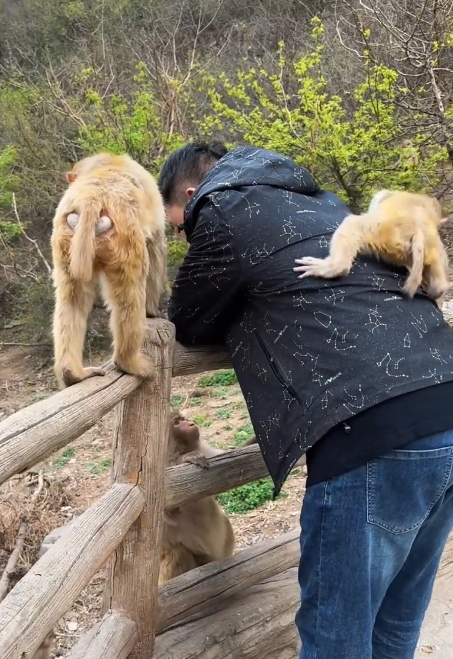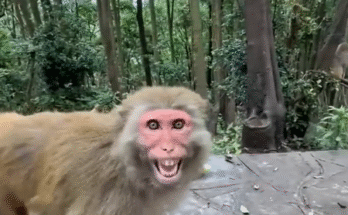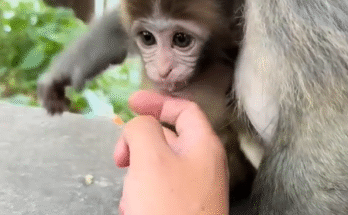
It was a bright, sunny morning in the jungle, the kind of day that promised adventure, laughter, and mischief. But as I approached the clearing where the troop of monkeys usually played, I realized something was very wrong. The monkeys, usually so lively and curious, seemed unusually aloof. One little monkey, the very one I had been hoping to play with, was sitting off to the side, grooming itself and entirely ignoring my presence. I sighed dramatically and muttered, “The monkey won’t play with me, what can you do? 😅”
This particular monkey, a tiny capuchin named Momo, had a reputation for being clever, curious, and impossibly playful—but only on their own terms. For days, I had been attempting to get Momo to interact with me, tossing small sticks, offering fruit, and making silly faces. Sometimes, it worked. Momo would leap from branch to branch, chattering happily, engaging in a game of chase, or even mimicking my movements in the funniest ways. But today, Momo wasn’t having it.
At first, I tried the usual tactics. I waved a bright banana enticingly, hoping to lure Momo into a game of tug-of-war. I jumped up and down, pretending to run, hoping the little monkey’s curiosity would outweigh its moodiness. Nothing. Momo blinked lazily, yawned, and continued grooming. “Okay,” I said to myself, “clearly this monkey is having a serious day. You win, Momo. But tomorrow…tomorrow we play.” 😅
It’s funny how monkeys, even tiny ones, seem to have personalities as distinct as humans. Momo’s reluctance to play wasn’t due to fear or boredom—it was clear that the little monkey was thinking, plotting, or maybe just enjoying a quiet moment. I remembered reading somewhere that monkeys need time to process their social environment, especially when they’re part of a troop. Maybe Momo had spent the night wrestling with siblings, exploring new parts of the jungle, or just decided that today, play was overrated. Whatever the reason, it was obvious: you cannot force a monkey to play.
I decided to change my strategy. Instead of trying to coax Momo directly, I observed from a distance. The troop was moving through the trees, foraging for fruit and teasing each other playfully. A younger monkey tried to steal a fig from an elder, causing a chain reaction of squeals and jumps. I watched quietly, hoping Momo’s curiosity would eventually win out. After a few minutes, it did. Slowly, Momo turned its head, watching a sibling swing from vine to vine, squealing with delight. Perhaps the fun was contagious.

Encouraged, I tried a new tactic: patience. I sat quietly, pretending to groom a branch like the other monkeys groom each other. Momo’s eyes flicked toward me again, this time with more interest. Slowly, the monkey approached, sniffing cautiously, still maintaining a small distance. I held my breath. And then, in a sudden burst of energy, Momo leaped onto a low branch near me, chattered a little, and grabbed the stick I had been holding. Success! A small smile spread across my face. Even if the monkey hadn’t “agreed” to play in the way I wanted, this interaction was a start.
From that moment, the game began—not exactly the game I had planned, but a game nonetheless. Momo tugged on the stick, tossed it into the air, and darted away, inviting me to follow. I chased the little monkey through low-hanging branches, careful not to scare or disturb. Momo was quick, clever, and unpredictable, and every leap, squeak, and sudden stop was a lesson in jungle agility. This was crazy monkey fun, the kind that makes you laugh, gasp, and marvel at the intelligence and spirit of these tiny creatures.
Of course, even in play, monkeys are masters of mischief. Just when I thought we were having a smooth game of chase, Momo would suddenly stop, freeze, and dart in the opposite direction, leaving me stumbling or sliding down a small incline. At one point, the monkey even grabbed a discarded leaf, waved it like a flag, and darted into a cluster of trees, teasing me as if saying, “Catch me if you can!” I laughed, breathless, realizing that playing with a monkey is never straightforward—but it’s always entertaining.
One of the things I learned during that morning is that interaction with monkeys requires flexibility and understanding. Unlike dogs or other domesticated animals, monkeys are wild, intelligent, and independent. They have moods, preferences, and clever strategies for engagement. When a monkey refuses to play, it’s not personal—it’s part of their nature. And yet, this very independence makes moments of shared fun so rewarding. When Momo finally returned, chattering and dropping a small fruit at my feet, I realized the game wasn’t about forcing play—it was about earning trust and participating in a spontaneous adventure together.
Monkeys, like humans, also need their space. After a few minutes of play, Momo suddenly darted away again, disappearing behind a tree. I watched, amused, realizing that the little monkey was taking breaks as needed. This was another important lesson: respect their boundaries. Trying to force interaction will never work with a creature as clever and independent as a monkey. Instead, patience, observation, and a willingness to join their game on their terms are key. 😅

As the day went on, I found myself captivated by the troop’s dynamics. Younger monkeys would chase each other, elders would sit and observe, and mischievous individuals like Momo would switch between play and rest with remarkable timing. Every small action—a squeak, a leap, a playful tug—was part of a larger story unfolding before my eyes. The lesson was clear: monkeys don’t need structured play to have fun. Their world is full of spontaneous games, tiny challenges, and bursts of laughter that make the jungle feel alive.
By late afternoon, Momo and I had shared several rounds of chase, tug-of-war, and mock wrestling. The little monkey had even allowed me to climb a low branch alongside him, showing a level of trust that was both exhilarating and heartwarming. Finally, tired and satisfied, Momo curled up near a small tree hollow, chattering softly to a sibling. I sat nearby, smiling, reflecting on the day’s adventures. The monkey hadn’t played in the way I initially wanted, but in the end, we had connected, shared joy, and enjoyed the unpredictable, hilarious nature of monkey antics.
So, what can you do when the monkey won’t play with you? 😅 You wait. You observe. You participate on their terms. You learn patience, respect, and the joy of spontaneity. Monkeys are playful, clever, and independent for a reason, and trying to force interaction often leads to frustration. But when you approach with curiosity, humor, and flexibility, even the most mischievous little monkeys—like Momo—will eventually invite you into their world, creating moments of laughter, fun, and unforgettable memories.
In conclusion, monkeys remind us of the unpredictability and joy of life. Sometimes, they refuse to play, leaving us scratching our heads and laughing at the absurdity of the situation. And other times, they allow us to join their game, turning a simple morning in the jungle into a chaotic, funny, and heartwarming adventure. Momo taught me that the best fun often comes unexpectedly, that trust and patience are more important than control, and that even a mischievous little monkey can teach big lessons about joy, curiosity, and the art of play. 😅
So next time a monkey refuses to play, remember: it’s not rejection—it’s nature. And in that waiting, observing, and joining on their terms, you might just experience the kind of crazy, delightful fun you never expected—but can’t forget.



